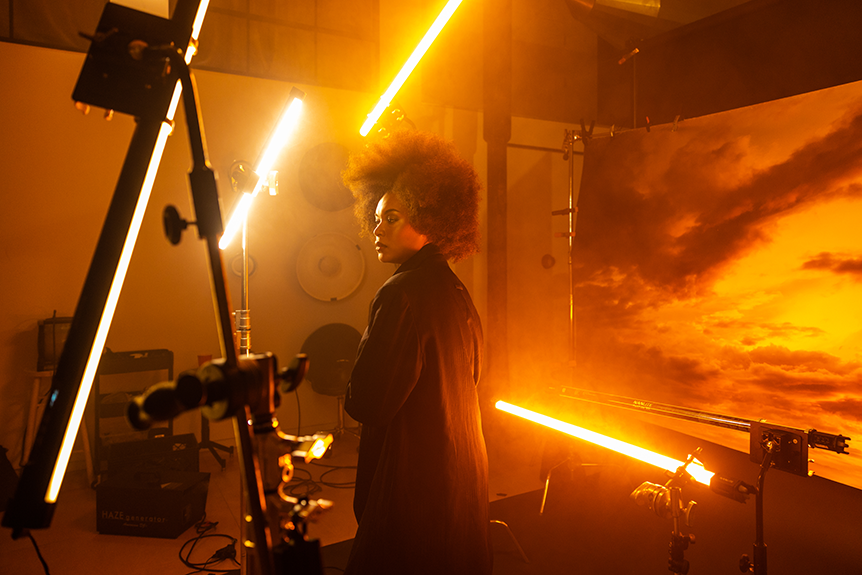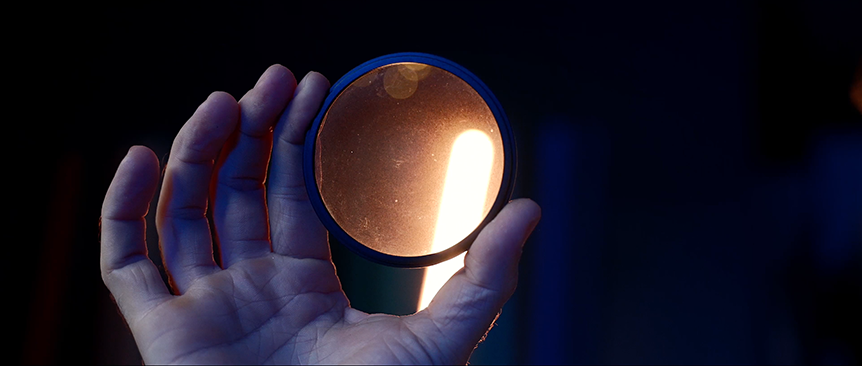
 8 minute read
8 minute read
Top Five Tips to Create Cinematic Images
FUJIFILM Creator Chris Knight takes you through some key tips to create a cinematic look and feel to your portraits
Video 2022 © Chris Knight
When I make a photo, I want it to do at least one of three things: express an idea, show a relationship, or convey an emotion. I often try to do as many as I can – but central to these aims is storytelling.
Storytelling is woven into the fabric of cinema. Everything in the frame means something – building towards that story. This includes light, color, composition, filtration, and physical effects. So, if we can borrow filmmaking’s approach in those areas, it will make our stills just as dramatic and captivating. In this chapter, we look at five ways to do it. You can choose to employ all of them at once or try just a few… whatever helps create your cinematic aesthetic.
The lights I’m using
Before we dive in, a word about kit. In this chapter, and the accompanying video, you’ll see I’m using continuous lighting. That’s not because I prefer it to flash – it’s simply the right tool for the job. Flash is perfect for power, or when I need to freeze movement. But here, with a motion component also required in the shape of the video, LEDs win.
Of course, continuous is a natural fit with the cinematic objective. It’s typically what’s used on a movie set, and helps you visualize better than flash. LEDs have recently grown in usefulness, too, and lights like those I’m using here – Nanlite PavoTubes and Forza 500 heads – are easy to position, powerful, cool in use, and some can even be set to deliver a vast spectrum of colors.

Photo 2022 © Chris Knight
1. Master cinematic three-point lighting
Three-point lighting is a staple in cinema. Its longevity is based on effectiveness, because it’s a style that creates depth and shape in an efficient way – but it’s also easy to vary, depending on the mood you want an image to have.
If you’ve come from a purely stills background, you might find three-point lighting works a little differently in moviemaking. A lot of photographers learn three-point as a style that uses two rim lights and a fill light, but traditionally in filmmaking, it’s a key light, a fill light, and a back light – also called a rim or hair light.
When these three lights are placed around the subject, they define the sides of it and give volume. Naturally, we can see the front and sides, lit by the key and fill, but we can’t see the back – so the back light adds an edge, separating it from the background. With these simple elements, we can define how something looks, its mood and its character, both of which are instrumental in cinema.
Check out these example images. By clicking the buttons below the image, you can see how the separate lights build into the final three-point arrangement.


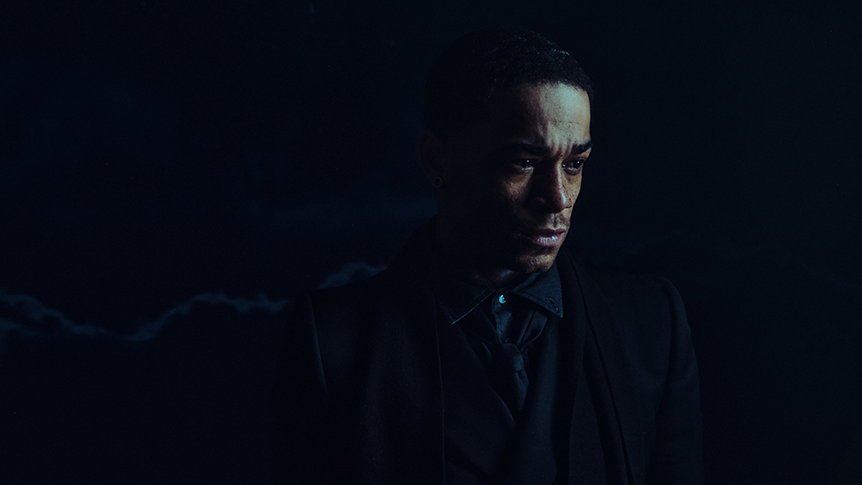



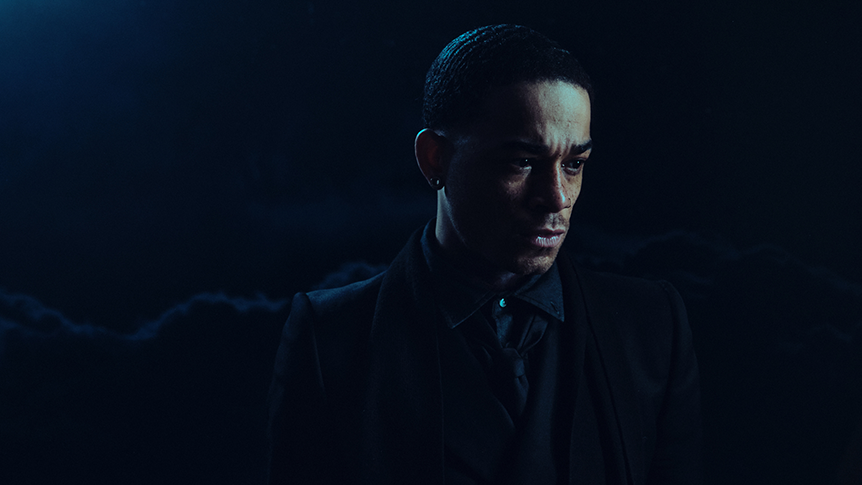


Photo 2022 © Chris Knight | All lights
Photo 2022 © Chris Knight | No lights
Photo 2022 © Chris Knight | Key light only
Photo 2022 © Chris Knight | Fill light only
Photo 2022 © Chris Knight | Back light only
Photo 2022 © Chris Knight | Key light and fill light
Photo 2022 © Chris Knight | Key light and back light
Photo 2022 © Chris Knight | Fill light and back light
Photo 2022 © Chris Knight | All lights
To break it down, the key light – called ‘key’ because it’s the most important in setting the overall tone, style, and exposure of the image – is usually set to the front of the subject. The fill light is usually placed opposite the key, also to the front of the subject, controlling the brightness of the shadows. The back light is usually directly from behind the subject, although not always opposite the key light. It gives shape and contour, but shouldn’t look unnatural – more of which we’ll cover in the section on motivated lighting.
Why ‘usually’? Well, it’s all there to be played with. You can alter the placement, modification, and relative strength of the lights in many ways. In the example images above, the fill is a lot lower in power than the key, increasing contrast. I also set the key light on the ‘short’ side of the subject’s face – that which is furthest from the camera, increasing the contrast further. The opposite, and more regular approach, is ‘broad’ lighting, where the closer side is illuminated and looks traditional and less cinematic.
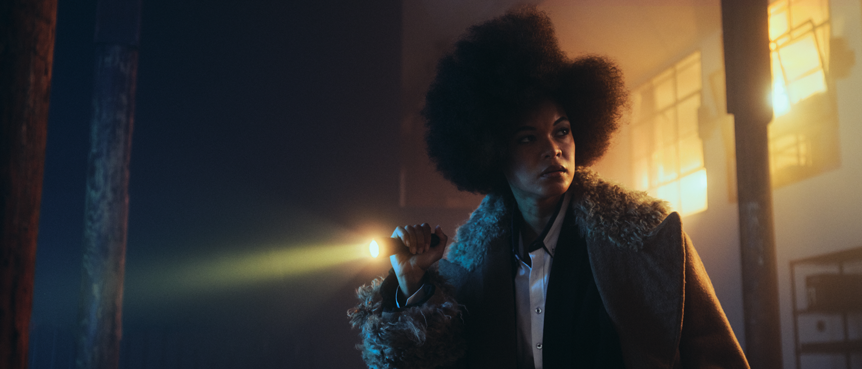
Photo 2022 © Chris Knight
2. Start motivating your light
Motivated light is a technique straight from movies, so it’s inevitably going to make photos look cinematic. In filmmaking situations, light is often added to a scene to emulate what would be there naturally, but maybe a more dramatic or stylized version. Lighting elements already in the scene are called ‘practicals’, and can be anything: a window, a chandelier, a candle, or a computer screen. It’s those we’re motivating, so when we ‘motivate the practical’, we adapt our lighting to the scene, making choices about the position, strength, and style of illumination. It looks like the practical is doing the work, even when it’s not.
Another difference between movies and stills is that cinematographers will light a whole scene, knowing the camera may move through, or around, in it. Photographers are more likely to think of a single angle. Light like a cinematographer, and you can explore the space creatively. That means lighting might not always be ‘perfect’, but can be more expressive and characterful.
In movies, motivated lighting tends to be invisible, so the viewer isn’t even aware of it. But once you understand this, you can choose to heighten and exaggerate the effect in stills, adding contrast to make the image more dramatic and theatrical. This means you don’t have to stay completely faithful, but be aware, because it still needs to make sense in the context of the scene.
In these examples, you can see the difference – swipe or click between them. On the first, the lighting is highly motivated; on the right, much less so. Notice how the light from the window comes from behind the subject, so in the motivated image, the key light is positioned accordingly, almost behind them. On the other image, the key is in front, so the light is much flatter and isn’t so motivated by the practical elements.
Essentially, this setup stays close to the three-point lighting described above. The window on the studio wall is standing in for a real one, but because the light is motivated, you wouldn’t know it. I used two Nanlite Forza 500s in that position, both gelled with Full Color Temperature Orange (CTO) filters to make them look warm, like low sun. That light is also modified by the window shape, and any dirt on the glass the light is coming through.
On the subject’s left, I used a PavoTube, dialed to a warm orange to match, playing on the connection to the window more strongly than the Forzas can do alone. On her right are three PavoTubes, dialed to blue to accentuate the color contrast – something we’ll cover in the next section. Finally, I added a neutral white light from the front, making the side light just a little more flattering.

Photo 2022 © Chris Knight
3. Tell your story with color
Color is a huge part of visual language, especially in moviemaking. In films, it’s used not only for visual appeal, but storytelling and narrative meaning. Color can tell your viewer how to feel, often on a subconscious level. Movies have professional colorists dedicated to this, working with the director and cinematographer to get the look right. You can apply the same to your stills.
Plan color and how it can help tell your story. Your cultural background defines how you see color in the first place, but different hues always mean different things. Blues often relate to coldness and detachment, but can also express peace. Reds suggest warmth, passion, anger, or danger. Yellows and greens reflect vibrancy and nature and, in some contexts, sickness.
Moving into practice, we can apply color schemes in several thoughtful and expressive ways, creating harmony or contrast, depending on the intention. Here are three examples.

Photo 2022 © Chris Knight
Monochromatic color means the hues in the image are very closely grouped. This creates a feeling of harmony, as well as simplifying the image. It’s often used in movies to identify particular characters, or phases in a story.

Photo 2022 © Chris Knight
Analogous color is also harmonious, but draws from a slightly wider palette. It’s not as restrictive as monochrome, but more natural and less stylized.
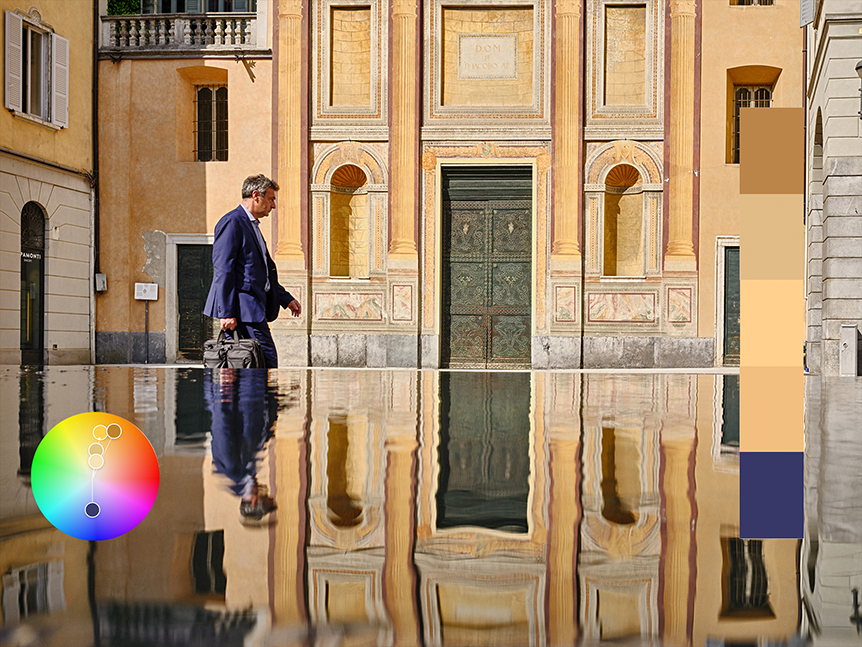
Photo 2022 © Chris Knight
Complementary color is the opposite of monochromatic. It takes hues from opposing sides of the spectrum, to create contrast. For example, yellow and purple in this case. Filmmakers often use combinations of teal and orange to make skin tones stand out.
Color can be added with careful selection of costumes, locations, and props, with your camera’s white balance, with lighting, and in post-production grading. In terms of the latter, minor editing is normal, but you’ll do a better job creating and capturing the color you want when shooting, rather than trying to layer it on after the event.

Photo 2022 © Chris Knight
As with motivated lighting, I like to exaggerate color. Returning to the motivated light image as an example, I pushed the contrast of blue and orange to make the effect more striking. As the subject was wearing brown, it also made sense to offset that with blues. In other cases, it’s good to use neutral-colored outfits, letting the colors of the lights alone tell the story for you. This is common with the color of movie props and costumes often looking different in real life to how they do on screen.
4. Work on your staging
Another huge component of visual language is staging. Effectively, this is everything you put in front of the lens – and in terms of composition, how you put it there. Again, cinematographers use different approaches compared to stills photographers. For starters, filmmakers will almost certainly be working at wider aspect ratios, so composition can be a little different.
An easy one to start with is the relative size you give to different subjects in the frame. This weighting helps tell the story. Generally, whoever’s larger in the frame is more important. If your subject is small in the frame, alone, you could be letting the audience know that they’re vulnerable, or simply dwarfed by the situation they’re in.
If they’re very large in the frame, almost overwhelming the space, you’re saying they’re strong. The same can be done with shooting from above or below the subject. If subjects are the same size in terms of visual weight, you can alter their prominence with lighting. For instance, having one lit in a contrasty way; the other in silhouette.
I also like to create backdrops that help tell the story in an image. In the example images, they’re photographic prints from stock, from on a large format printer, using 44-inch-wide canvas rolls for durability. You can also use matte paper, although it lacks the longevity. Gloss is a problem because it’ll reflect your lighting. Depending on the look you want, add a light to your setup, illuminating the backdrop.

Photo 2022 © Chris Knight
5. Give your light some volume
The light you add to a scene can be a compositional element in itself. This is something we call volume. Volume can be seen in shafts of light coming through a window, or the glow of backlit mist, lens flares, or blooms that come from light sources in the frame. They’re all a staple of movies, so adding them to stills will give you instant cinematic impact.

Photo 2022 © Chris Knight
Volume most often comes from a haze machine. This is different from a fog machine, giving a lighter, less cloudy look. Hazing is used all the time on film sets, without the audience being aware. It’s fine mist that adds depth to sets and locations, or makes the subjects stand out. Getting a haze machine is great, but haze-in-a-can can do a similar job at smaller locations. Just as with color and contrast, I like a fair bit of haze, but it’s all down to personal taste.

Photo 2022 © Chris Knight
Movies also look different to stills because of the optics used. Modern stills lenses, like those in the GFX System or X Series, are engineered to suppress flare, maximize contrast, and concentrate on ultimate sharpness. But many cinematographers prefer a softer, more organic look, seeing defects like flare as characterful. You can shoot with movie lenses – and the next chapter is an example of that – but adding filters is a great option to have.
I often use Tiffen Black Pro Mist filters, which give a softer and more pastelly look, with diffused highlights and lower contrast overall – while minimizing changes to color. I also recommend Tiffen Glimmerglass, another line of diffusion filters that give a soft glow around light sources and specular surfaces. Also exceptional are Schneider Optics’ Hollywood Black Magic filters, which soften a subject’s skin texture, and diffuse highlights, without affecting deep blacks or color saturation.
Put it all together
As you read through this chapter, and watched the accompanying video lesson, you’ll have started to develop ideas about images you could make. Let those grow and keep thinking about ways that the light, color, and composition can help tell your story. My concept-driven work is 80% planned out before the day, letting me be more spontaneous and creative on set – give it a try yourself. Make notes and keep working on them, so you have your plan well-versed by the time it comes to shoot.















